PPMP20011: Projects Negotiation & Conflict Report - Queensland
VerifiedAdded on 2023/06/14
|7
|2852
|469
Report
AI Summary
This report analyzes project negotiation and conflict within the context of the Queensland Health payroll program, focusing on four key projects: forward strategy for payroll system, governance and decision-making, people and change, and funding. It identifies the characteristics of each project based on frameworks like NCTP and organizational learning, and examines the negotiating positions and potential conflicts of participants including owners, designers, and contractors. The report recommends integrative negotiation positions and methods to resolve challenges, create project value, and foster stakeholder communication. The preferred procurement outcomes emphasize integrated design, team collaboration, and stakeholder engagement to ensure successful project delivery.
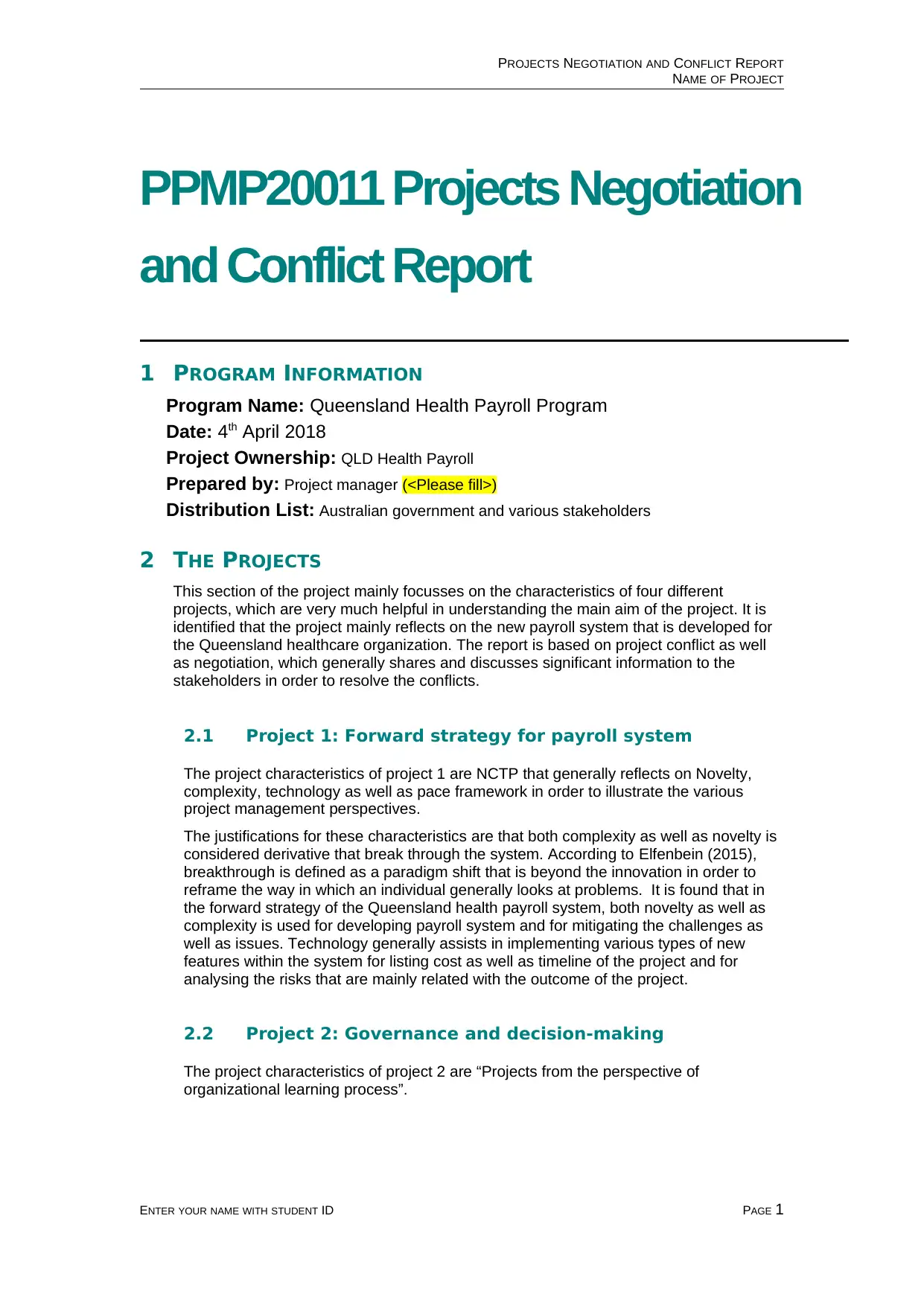
PROJECTS NEGOTIATION AND CONFLICT REPORT
NAME OF PROJECT
PPMP20011 Projects Negotiation
and Conflict Report
1 PROGRAM INFORMATION
Program Name: Queensland Health Payroll Program
Date: 4th April 2018
Project Ownership: QLD Health Payroll
Prepared by: Project manager (<Please fill>)
Distribution List: Australian government and various stakeholders
2 THE PROJECTS
This section of the project mainly focusses on the characteristics of four different
projects, which are very much helpful in understanding the main aim of the project. It is
identified that the project mainly reflects on the new payroll system that is developed for
the Queensland healthcare organization. The report is based on project conflict as well
as negotiation, which generally shares and discusses significant information to the
stakeholders in order to resolve the conflicts.
2.1 Project 1: Forward strategy for payroll system
The project characteristics of project 1 are NCTP that generally reflects on Novelty,
complexity, technology as well as pace framework in order to illustrate the various
project management perspectives.
The justifications for these characteristics are that both complexity as well as novelty is
considered derivative that break through the system. According to Elfenbein (2015),
breakthrough is defined as a paradigm shift that is beyond the innovation in order to
reframe the way in which an individual generally looks at problems. It is found that in
the forward strategy of the Queensland health payroll system, both novelty as well as
complexity is used for developing payroll system and for mitigating the challenges as
well as issues. Technology generally assists in implementing various types of new
features within the system for listing cost as well as timeline of the project and for
analysing the risks that are mainly related with the outcome of the project.
2.2 Project 2: Governance and decision-making
The project characteristics of project 2 are “Projects from the perspective of
organizational learning process”.
ENTER YOUR NAME WITH STUDENT ID PAGE 1
NAME OF PROJECT
PPMP20011 Projects Negotiation
and Conflict Report
1 PROGRAM INFORMATION
Program Name: Queensland Health Payroll Program
Date: 4th April 2018
Project Ownership: QLD Health Payroll
Prepared by: Project manager (<Please fill>)
Distribution List: Australian government and various stakeholders
2 THE PROJECTS
This section of the project mainly focusses on the characteristics of four different
projects, which are very much helpful in understanding the main aim of the project. It is
identified that the project mainly reflects on the new payroll system that is developed for
the Queensland healthcare organization. The report is based on project conflict as well
as negotiation, which generally shares and discusses significant information to the
stakeholders in order to resolve the conflicts.
2.1 Project 1: Forward strategy for payroll system
The project characteristics of project 1 are NCTP that generally reflects on Novelty,
complexity, technology as well as pace framework in order to illustrate the various
project management perspectives.
The justifications for these characteristics are that both complexity as well as novelty is
considered derivative that break through the system. According to Elfenbein (2015),
breakthrough is defined as a paradigm shift that is beyond the innovation in order to
reframe the way in which an individual generally looks at problems. It is found that in
the forward strategy of the Queensland health payroll system, both novelty as well as
complexity is used for developing payroll system and for mitigating the challenges as
well as issues. Technology generally assists in implementing various types of new
features within the system for listing cost as well as timeline of the project and for
analysing the risks that are mainly related with the outcome of the project.
2.2 Project 2: Governance and decision-making
The project characteristics of project 2 are “Projects from the perspective of
organizational learning process”.
ENTER YOUR NAME WITH STUDENT ID PAGE 1
Paraphrase This Document
Need a fresh take? Get an instant paraphrase of this document with our AI Paraphraser
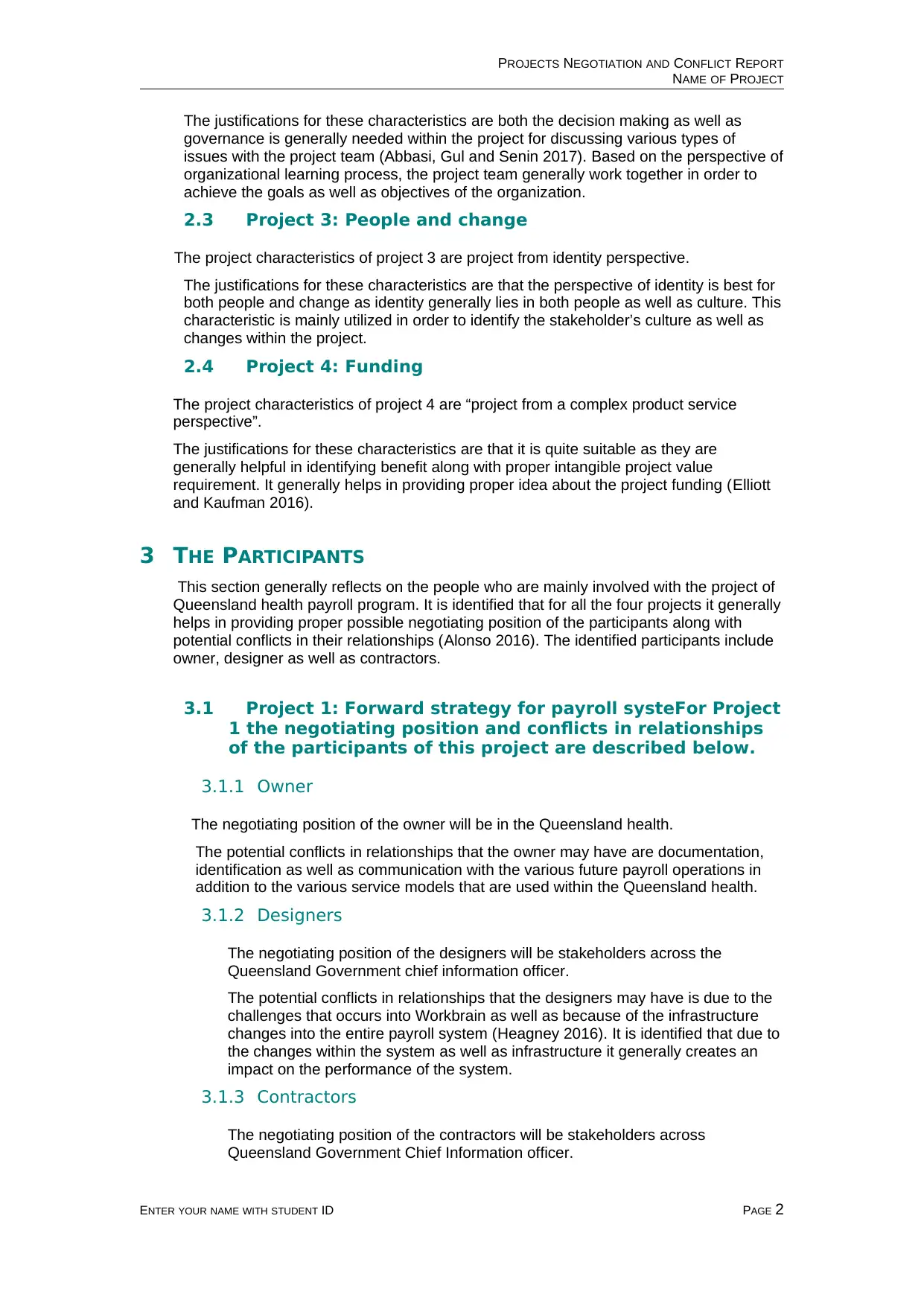
PROJECTS NEGOTIATION AND CONFLICT REPORT
NAME OF PROJECT
The justifications for these characteristics are both the decision making as well as
governance is generally needed within the project for discussing various types of
issues with the project team (Abbasi, Gul and Senin 2017). Based on the perspective of
organizational learning process, the project team generally work together in order to
achieve the goals as well as objectives of the organization.
2.3 Project 3: People and change
The project characteristics of project 3 are project from identity perspective.
The justifications for these characteristics are that the perspective of identity is best for
both people and change as identity generally lies in both people as well as culture. This
characteristic is mainly utilized in order to identify the stakeholder’s culture as well as
changes within the project.
2.4 Project 4: Funding
The project characteristics of project 4 are “project from a complex product service
perspective”.
The justifications for these characteristics are that it is quite suitable as they are
generally helpful in identifying benefit along with proper intangible project value
requirement. It generally helps in providing proper idea about the project funding (Elliott
and Kaufman 2016).
3 THE PARTICIPANTS
This section generally reflects on the people who are mainly involved with the project of
Queensland health payroll program. It is identified that for all the four projects it generally
helps in providing proper possible negotiating position of the participants along with
potential conflicts in their relationships (Alonso 2016). The identified participants include
owner, designer as well as contractors.
3.1 Project 1: Forward strategy for payroll systeFor Project
1 the negotiating position and conflicts in relationships
of the participants of this project are described below.
3.1.1 Owner
The negotiating position of the owner will be in the Queensland health.
The potential conflicts in relationships that the owner may have are documentation,
identification as well as communication with the various future payroll operations in
addition to the various service models that are used within the Queensland health.
3.1.2 Designers
The negotiating position of the designers will be stakeholders across the
Queensland Government chief information officer.
The potential conflicts in relationships that the designers may have is due to the
challenges that occurs into Workbrain as well as because of the infrastructure
changes into the entire payroll system (Heagney 2016). It is identified that due to
the changes within the system as well as infrastructure it generally creates an
impact on the performance of the system.
3.1.3 Contractors
The negotiating position of the contractors will be stakeholders across
Queensland Government Chief Information officer.
ENTER YOUR NAME WITH STUDENT ID PAGE 2
NAME OF PROJECT
The justifications for these characteristics are both the decision making as well as
governance is generally needed within the project for discussing various types of
issues with the project team (Abbasi, Gul and Senin 2017). Based on the perspective of
organizational learning process, the project team generally work together in order to
achieve the goals as well as objectives of the organization.
2.3 Project 3: People and change
The project characteristics of project 3 are project from identity perspective.
The justifications for these characteristics are that the perspective of identity is best for
both people and change as identity generally lies in both people as well as culture. This
characteristic is mainly utilized in order to identify the stakeholder’s culture as well as
changes within the project.
2.4 Project 4: Funding
The project characteristics of project 4 are “project from a complex product service
perspective”.
The justifications for these characteristics are that it is quite suitable as they are
generally helpful in identifying benefit along with proper intangible project value
requirement. It generally helps in providing proper idea about the project funding (Elliott
and Kaufman 2016).
3 THE PARTICIPANTS
This section generally reflects on the people who are mainly involved with the project of
Queensland health payroll program. It is identified that for all the four projects it generally
helps in providing proper possible negotiating position of the participants along with
potential conflicts in their relationships (Alonso 2016). The identified participants include
owner, designer as well as contractors.
3.1 Project 1: Forward strategy for payroll systeFor Project
1 the negotiating position and conflicts in relationships
of the participants of this project are described below.
3.1.1 Owner
The negotiating position of the owner will be in the Queensland health.
The potential conflicts in relationships that the owner may have are documentation,
identification as well as communication with the various future payroll operations in
addition to the various service models that are used within the Queensland health.
3.1.2 Designers
The negotiating position of the designers will be stakeholders across the
Queensland Government chief information officer.
The potential conflicts in relationships that the designers may have is due to the
challenges that occurs into Workbrain as well as because of the infrastructure
changes into the entire payroll system (Heagney 2016). It is identified that due to
the changes within the system as well as infrastructure it generally creates an
impact on the performance of the system.
3.1.3 Contractors
The negotiating position of the contractors will be stakeholders across
Queensland Government Chief Information officer.
ENTER YOUR NAME WITH STUDENT ID PAGE 2
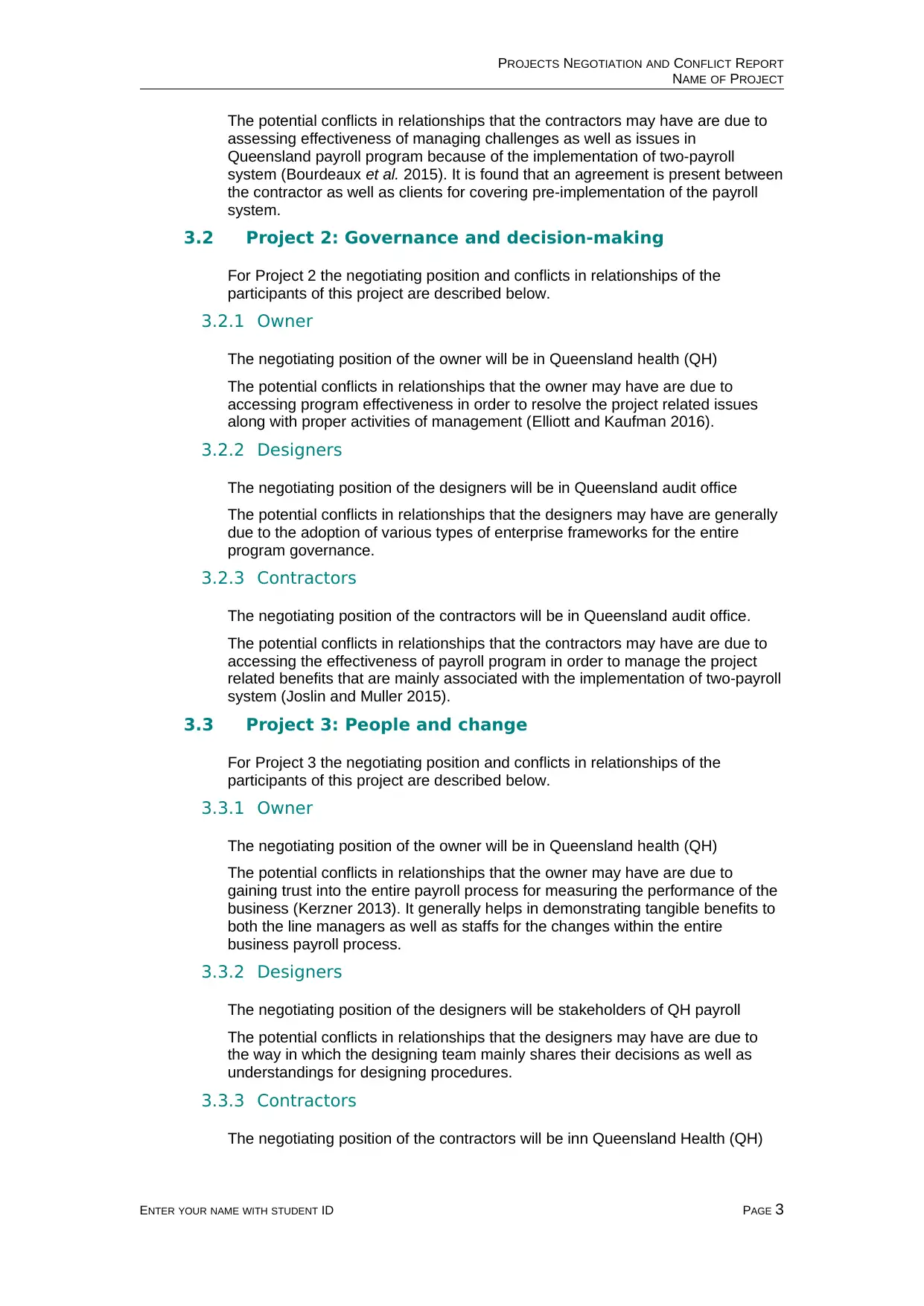
PROJECTS NEGOTIATION AND CONFLICT REPORT
NAME OF PROJECT
The potential conflicts in relationships that the contractors may have are due to
assessing effectiveness of managing challenges as well as issues in
Queensland payroll program because of the implementation of two-payroll
system (Bourdeaux et al. 2015). It is found that an agreement is present between
the contractor as well as clients for covering pre-implementation of the payroll
system.
3.2 Project 2: Governance and decision-making
For Project 2 the negotiating position and conflicts in relationships of the
participants of this project are described below.
3.2.1 Owner
The negotiating position of the owner will be in Queensland health (QH)
The potential conflicts in relationships that the owner may have are due to
accessing program effectiveness in order to resolve the project related issues
along with proper activities of management (Elliott and Kaufman 2016).
3.2.2 Designers
The negotiating position of the designers will be in Queensland audit office
The potential conflicts in relationships that the designers may have are generally
due to the adoption of various types of enterprise frameworks for the entire
program governance.
3.2.3 Contractors
The negotiating position of the contractors will be in Queensland audit office.
The potential conflicts in relationships that the contractors may have are due to
accessing the effectiveness of payroll program in order to manage the project
related benefits that are mainly associated with the implementation of two-payroll
system (Joslin and Muller 2015).
3.3 Project 3: People and change
For Project 3 the negotiating position and conflicts in relationships of the
participants of this project are described below.
3.3.1 Owner
The negotiating position of the owner will be in Queensland health (QH)
The potential conflicts in relationships that the owner may have are due to
gaining trust into the entire payroll process for measuring the performance of the
business (Kerzner 2013). It generally helps in demonstrating tangible benefits to
both the line managers as well as staffs for the changes within the entire
business payroll process.
3.3.2 Designers
The negotiating position of the designers will be stakeholders of QH payroll
The potential conflicts in relationships that the designers may have are due to
the way in which the designing team mainly shares their decisions as well as
understandings for designing procedures.
3.3.3 Contractors
The negotiating position of the contractors will be inn Queensland Health (QH)
ENTER YOUR NAME WITH STUDENT ID PAGE 3
NAME OF PROJECT
The potential conflicts in relationships that the contractors may have are due to
assessing effectiveness of managing challenges as well as issues in
Queensland payroll program because of the implementation of two-payroll
system (Bourdeaux et al. 2015). It is found that an agreement is present between
the contractor as well as clients for covering pre-implementation of the payroll
system.
3.2 Project 2: Governance and decision-making
For Project 2 the negotiating position and conflicts in relationships of the
participants of this project are described below.
3.2.1 Owner
The negotiating position of the owner will be in Queensland health (QH)
The potential conflicts in relationships that the owner may have are due to
accessing program effectiveness in order to resolve the project related issues
along with proper activities of management (Elliott and Kaufman 2016).
3.2.2 Designers
The negotiating position of the designers will be in Queensland audit office
The potential conflicts in relationships that the designers may have are generally
due to the adoption of various types of enterprise frameworks for the entire
program governance.
3.2.3 Contractors
The negotiating position of the contractors will be in Queensland audit office.
The potential conflicts in relationships that the contractors may have are due to
accessing the effectiveness of payroll program in order to manage the project
related benefits that are mainly associated with the implementation of two-payroll
system (Joslin and Muller 2015).
3.3 Project 3: People and change
For Project 3 the negotiating position and conflicts in relationships of the
participants of this project are described below.
3.3.1 Owner
The negotiating position of the owner will be in Queensland health (QH)
The potential conflicts in relationships that the owner may have are due to
gaining trust into the entire payroll process for measuring the performance of the
business (Kerzner 2013). It generally helps in demonstrating tangible benefits to
both the line managers as well as staffs for the changes within the entire
business payroll process.
3.3.2 Designers
The negotiating position of the designers will be stakeholders of QH payroll
The potential conflicts in relationships that the designers may have are due to
the way in which the designing team mainly shares their decisions as well as
understandings for designing procedures.
3.3.3 Contractors
The negotiating position of the contractors will be inn Queensland Health (QH)
ENTER YOUR NAME WITH STUDENT ID PAGE 3
⊘ This is a preview!⊘
Do you want full access?
Subscribe today to unlock all pages.

Trusted by 1+ million students worldwide
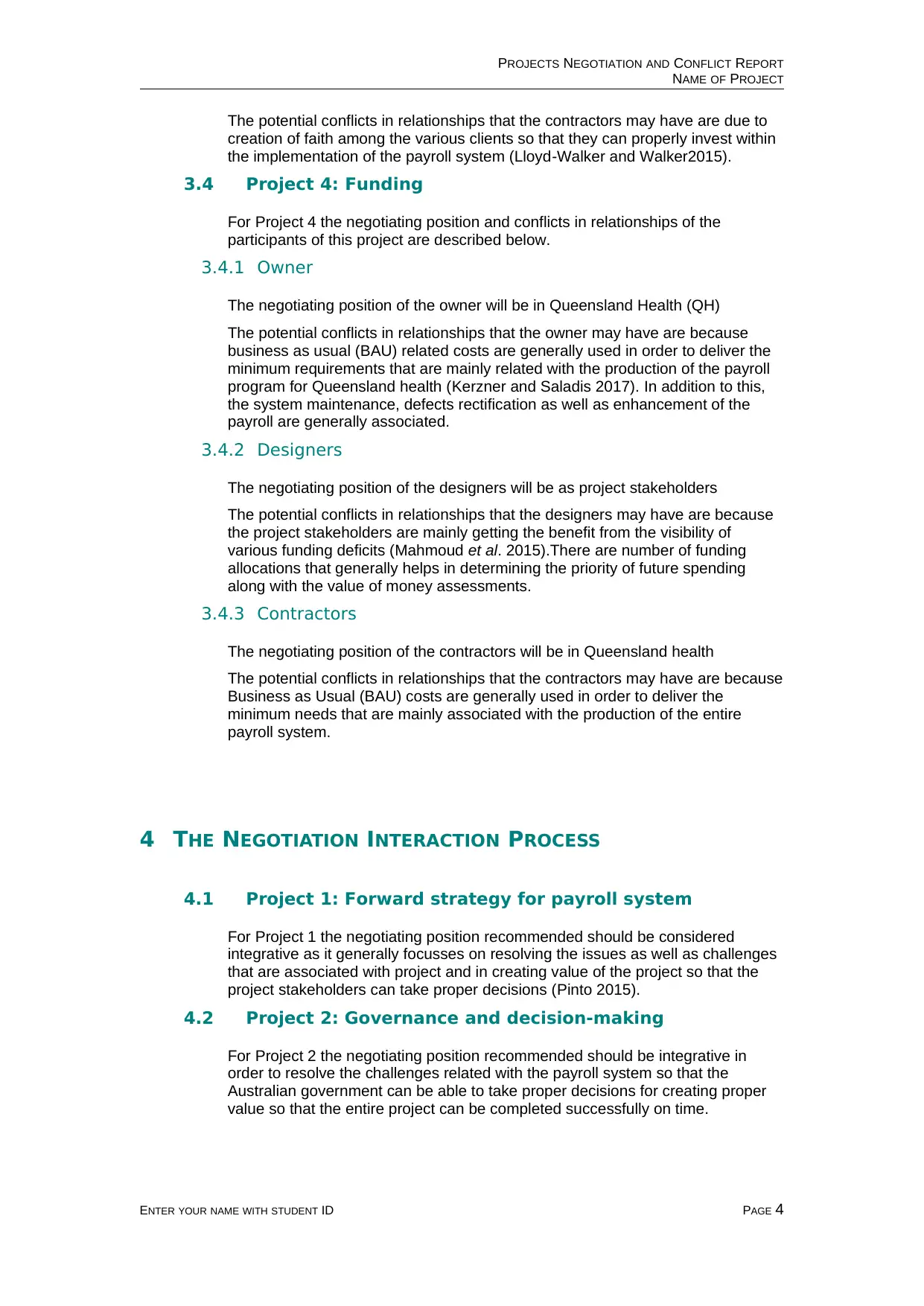
PROJECTS NEGOTIATION AND CONFLICT REPORT
NAME OF PROJECT
The potential conflicts in relationships that the contractors may have are due to
creation of faith among the various clients so that they can properly invest within
the implementation of the payroll system (Lloyd-Walker and Walker2015).
3.4 Project 4: Funding
For Project 4 the negotiating position and conflicts in relationships of the
participants of this project are described below.
3.4.1 Owner
The negotiating position of the owner will be in Queensland Health (QH)
The potential conflicts in relationships that the owner may have are because
business as usual (BAU) related costs are generally used in order to deliver the
minimum requirements that are mainly related with the production of the payroll
program for Queensland health (Kerzner and Saladis 2017). In addition to this,
the system maintenance, defects rectification as well as enhancement of the
payroll are generally associated.
3.4.2 Designers
The negotiating position of the designers will be as project stakeholders
The potential conflicts in relationships that the designers may have are because
the project stakeholders are mainly getting the benefit from the visibility of
various funding deficits (Mahmoud et al. 2015).There are number of funding
allocations that generally helps in determining the priority of future spending
along with the value of money assessments.
3.4.3 Contractors
The negotiating position of the contractors will be in Queensland health
The potential conflicts in relationships that the contractors may have are because
Business as Usual (BAU) costs are generally used in order to deliver the
minimum needs that are mainly associated with the production of the entire
payroll system.
4 THE NEGOTIATION INTERACTION PROCESS
4.1 Project 1: Forward strategy for payroll system
For Project 1 the negotiating position recommended should be considered
integrative as it generally focusses on resolving the issues as well as challenges
that are associated with project and in creating value of the project so that the
project stakeholders can take proper decisions (Pinto 2015).
4.2 Project 2: Governance and decision-making
For Project 2 the negotiating position recommended should be integrative in
order to resolve the challenges related with the payroll system so that the
Australian government can be able to take proper decisions for creating proper
value so that the entire project can be completed successfully on time.
ENTER YOUR NAME WITH STUDENT ID PAGE 4
NAME OF PROJECT
The potential conflicts in relationships that the contractors may have are due to
creation of faith among the various clients so that they can properly invest within
the implementation of the payroll system (Lloyd-Walker and Walker2015).
3.4 Project 4: Funding
For Project 4 the negotiating position and conflicts in relationships of the
participants of this project are described below.
3.4.1 Owner
The negotiating position of the owner will be in Queensland Health (QH)
The potential conflicts in relationships that the owner may have are because
business as usual (BAU) related costs are generally used in order to deliver the
minimum requirements that are mainly related with the production of the payroll
program for Queensland health (Kerzner and Saladis 2017). In addition to this,
the system maintenance, defects rectification as well as enhancement of the
payroll are generally associated.
3.4.2 Designers
The negotiating position of the designers will be as project stakeholders
The potential conflicts in relationships that the designers may have are because
the project stakeholders are mainly getting the benefit from the visibility of
various funding deficits (Mahmoud et al. 2015).There are number of funding
allocations that generally helps in determining the priority of future spending
along with the value of money assessments.
3.4.3 Contractors
The negotiating position of the contractors will be in Queensland health
The potential conflicts in relationships that the contractors may have are because
Business as Usual (BAU) costs are generally used in order to deliver the
minimum needs that are mainly associated with the production of the entire
payroll system.
4 THE NEGOTIATION INTERACTION PROCESS
4.1 Project 1: Forward strategy for payroll system
For Project 1 the negotiating position recommended should be considered
integrative as it generally focusses on resolving the issues as well as challenges
that are associated with project and in creating value of the project so that the
project stakeholders can take proper decisions (Pinto 2015).
4.2 Project 2: Governance and decision-making
For Project 2 the negotiating position recommended should be integrative in
order to resolve the challenges related with the payroll system so that the
Australian government can be able to take proper decisions for creating proper
value so that the entire project can be completed successfully on time.
ENTER YOUR NAME WITH STUDENT ID PAGE 4
Paraphrase This Document
Need a fresh take? Get an instant paraphrase of this document with our AI Paraphraser
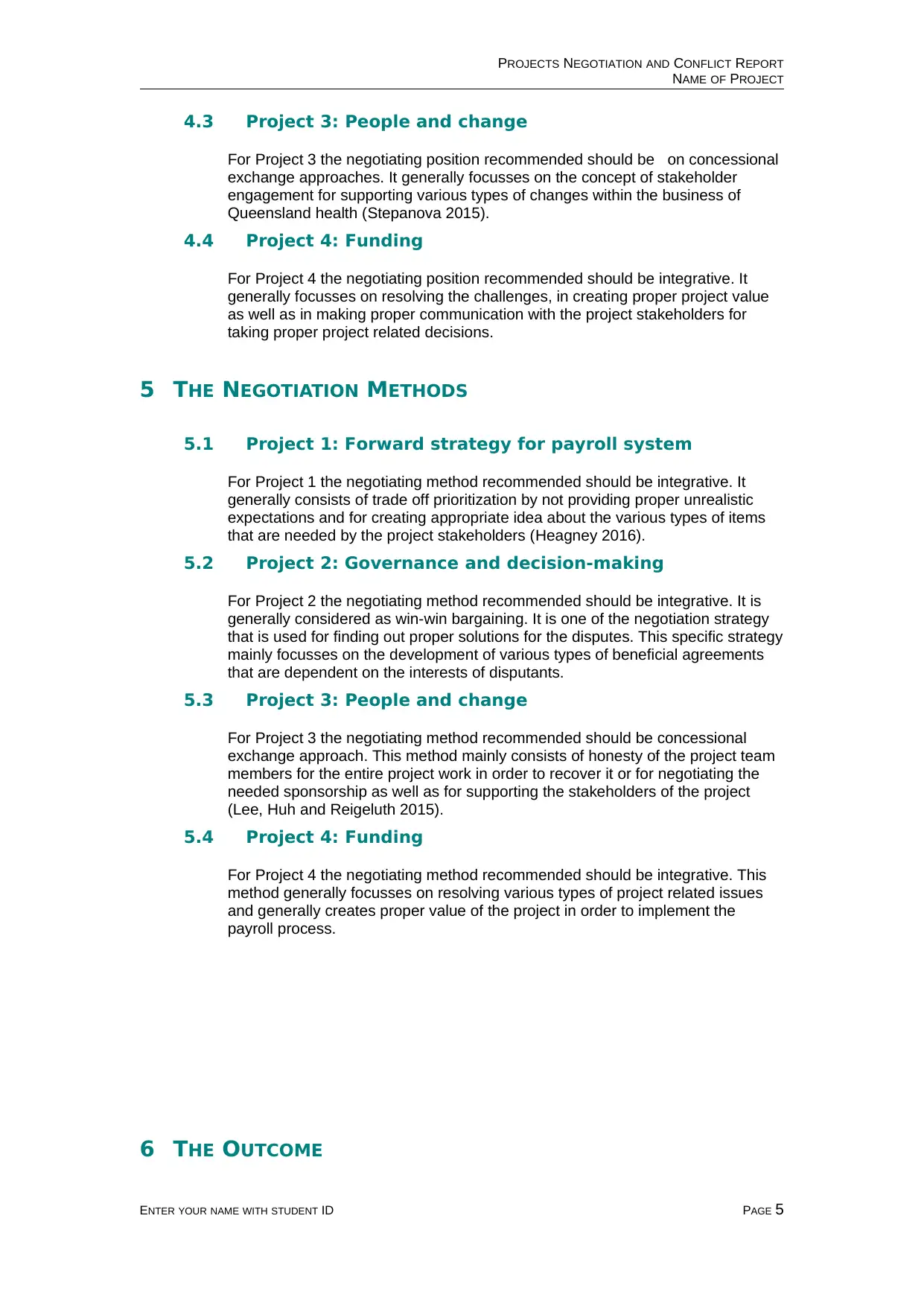
PROJECTS NEGOTIATION AND CONFLICT REPORT
NAME OF PROJECT
4.3 Project 3: People and change
For Project 3 the negotiating position recommended should be on concessional
exchange approaches. It generally focusses on the concept of stakeholder
engagement for supporting various types of changes within the business of
Queensland health (Stepanova 2015).
4.4 Project 4: Funding
For Project 4 the negotiating position recommended should be integrative. It
generally focusses on resolving the challenges, in creating proper project value
as well as in making proper communication with the project stakeholders for
taking proper project related decisions.
5 THE NEGOTIATION METHODS
5.1 Project 1: Forward strategy for payroll system
For Project 1 the negotiating method recommended should be integrative. It
generally consists of trade off prioritization by not providing proper unrealistic
expectations and for creating appropriate idea about the various types of items
that are needed by the project stakeholders (Heagney 2016).
5.2 Project 2: Governance and decision-making
For Project 2 the negotiating method recommended should be integrative. It is
generally considered as win-win bargaining. It is one of the negotiation strategy
that is used for finding out proper solutions for the disputes. This specific strategy
mainly focusses on the development of various types of beneficial agreements
that are dependent on the interests of disputants.
5.3 Project 3: People and change
For Project 3 the negotiating method recommended should be concessional
exchange approach. This method mainly consists of honesty of the project team
members for the entire project work in order to recover it or for negotiating the
needed sponsorship as well as for supporting the stakeholders of the project
(Lee, Huh and Reigeluth 2015).
5.4 Project 4: Funding
For Project 4 the negotiating method recommended should be integrative. This
method generally focusses on resolving various types of project related issues
and generally creates proper value of the project in order to implement the
payroll process.
6 THE OUTCOME
ENTER YOUR NAME WITH STUDENT ID PAGE 5
NAME OF PROJECT
4.3 Project 3: People and change
For Project 3 the negotiating position recommended should be on concessional
exchange approaches. It generally focusses on the concept of stakeholder
engagement for supporting various types of changes within the business of
Queensland health (Stepanova 2015).
4.4 Project 4: Funding
For Project 4 the negotiating position recommended should be integrative. It
generally focusses on resolving the challenges, in creating proper project value
as well as in making proper communication with the project stakeholders for
taking proper project related decisions.
5 THE NEGOTIATION METHODS
5.1 Project 1: Forward strategy for payroll system
For Project 1 the negotiating method recommended should be integrative. It
generally consists of trade off prioritization by not providing proper unrealistic
expectations and for creating appropriate idea about the various types of items
that are needed by the project stakeholders (Heagney 2016).
5.2 Project 2: Governance and decision-making
For Project 2 the negotiating method recommended should be integrative. It is
generally considered as win-win bargaining. It is one of the negotiation strategy
that is used for finding out proper solutions for the disputes. This specific strategy
mainly focusses on the development of various types of beneficial agreements
that are dependent on the interests of disputants.
5.3 Project 3: People and change
For Project 3 the negotiating method recommended should be concessional
exchange approach. This method mainly consists of honesty of the project team
members for the entire project work in order to recover it or for negotiating the
needed sponsorship as well as for supporting the stakeholders of the project
(Lee, Huh and Reigeluth 2015).
5.4 Project 4: Funding
For Project 4 the negotiating method recommended should be integrative. This
method generally focusses on resolving various types of project related issues
and generally creates proper value of the project in order to implement the
payroll process.
6 THE OUTCOME
ENTER YOUR NAME WITH STUDENT ID PAGE 5
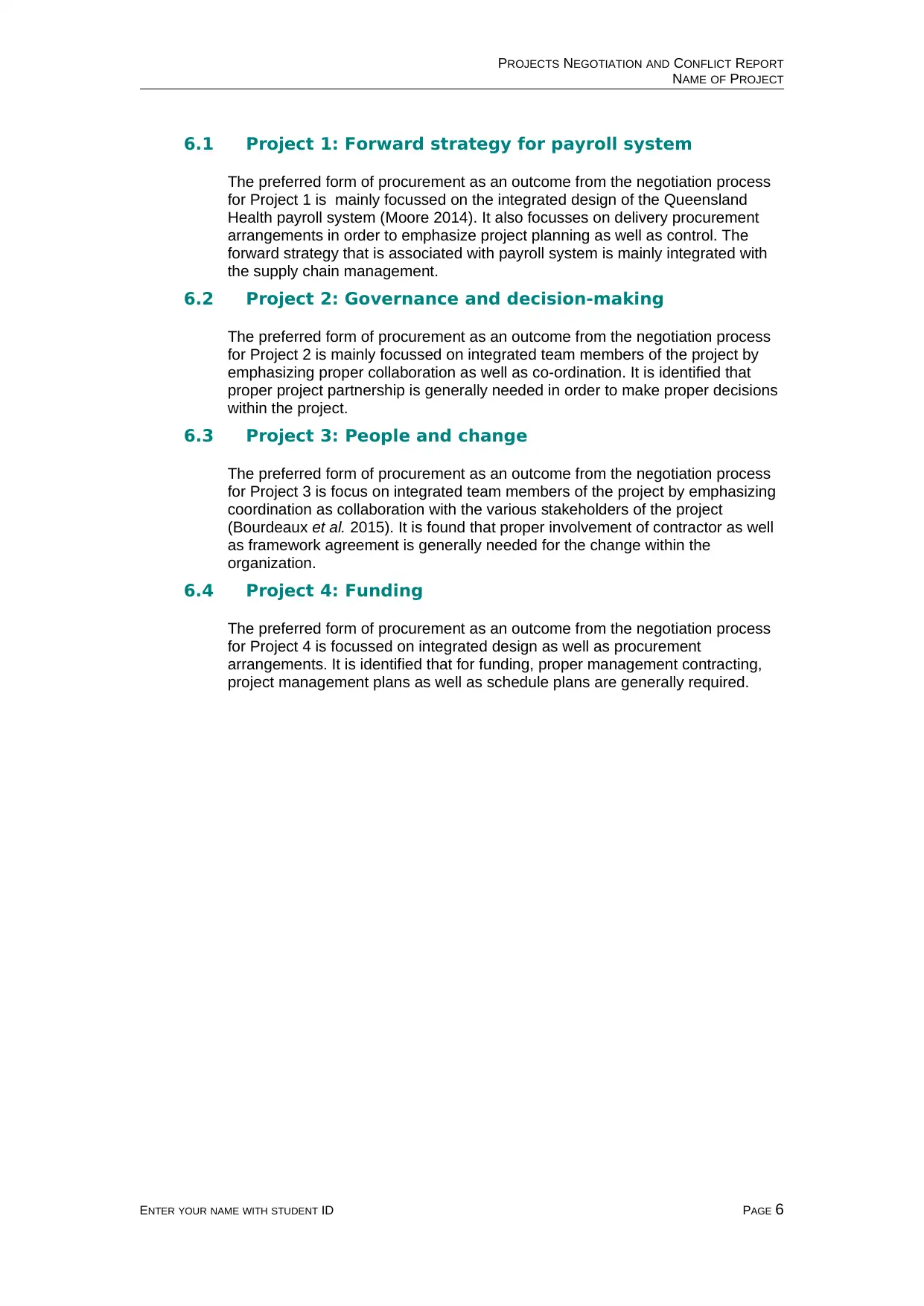
PROJECTS NEGOTIATION AND CONFLICT REPORT
NAME OF PROJECT
6.1 Project 1: Forward strategy for payroll system
The preferred form of procurement as an outcome from the negotiation process
for Project 1 is mainly focussed on the integrated design of the Queensland
Health payroll system (Moore 2014). It also focusses on delivery procurement
arrangements in order to emphasize project planning as well as control. The
forward strategy that is associated with payroll system is mainly integrated with
the supply chain management.
6.2 Project 2: Governance and decision-making
The preferred form of procurement as an outcome from the negotiation process
for Project 2 is mainly focussed on integrated team members of the project by
emphasizing proper collaboration as well as co-ordination. It is identified that
proper project partnership is generally needed in order to make proper decisions
within the project.
6.3 Project 3: People and change
The preferred form of procurement as an outcome from the negotiation process
for Project 3 is focus on integrated team members of the project by emphasizing
coordination as collaboration with the various stakeholders of the project
(Bourdeaux et al. 2015). It is found that proper involvement of contractor as well
as framework agreement is generally needed for the change within the
organization.
6.4 Project 4: Funding
The preferred form of procurement as an outcome from the negotiation process
for Project 4 is focussed on integrated design as well as procurement
arrangements. It is identified that for funding, proper management contracting,
project management plans as well as schedule plans are generally required.
ENTER YOUR NAME WITH STUDENT ID PAGE 6
NAME OF PROJECT
6.1 Project 1: Forward strategy for payroll system
The preferred form of procurement as an outcome from the negotiation process
for Project 1 is mainly focussed on the integrated design of the Queensland
Health payroll system (Moore 2014). It also focusses on delivery procurement
arrangements in order to emphasize project planning as well as control. The
forward strategy that is associated with payroll system is mainly integrated with
the supply chain management.
6.2 Project 2: Governance and decision-making
The preferred form of procurement as an outcome from the negotiation process
for Project 2 is mainly focussed on integrated team members of the project by
emphasizing proper collaboration as well as co-ordination. It is identified that
proper project partnership is generally needed in order to make proper decisions
within the project.
6.3 Project 3: People and change
The preferred form of procurement as an outcome from the negotiation process
for Project 3 is focus on integrated team members of the project by emphasizing
coordination as collaboration with the various stakeholders of the project
(Bourdeaux et al. 2015). It is found that proper involvement of contractor as well
as framework agreement is generally needed for the change within the
organization.
6.4 Project 4: Funding
The preferred form of procurement as an outcome from the negotiation process
for Project 4 is focussed on integrated design as well as procurement
arrangements. It is identified that for funding, proper management contracting,
project management plans as well as schedule plans are generally required.
ENTER YOUR NAME WITH STUDENT ID PAGE 6
⊘ This is a preview!⊘
Do you want full access?
Subscribe today to unlock all pages.

Trusted by 1+ million students worldwide
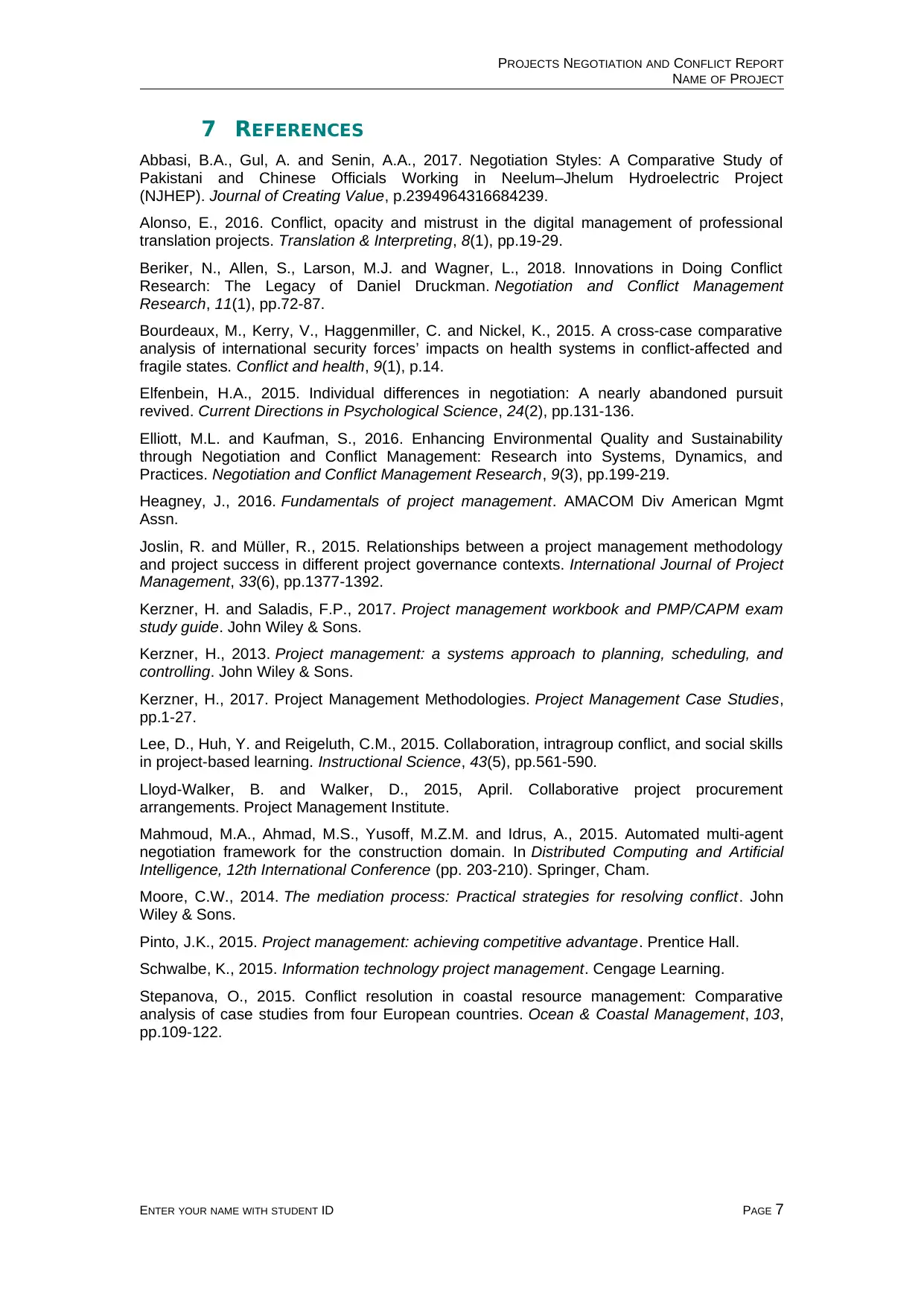
PROJECTS NEGOTIATION AND CONFLICT REPORT
NAME OF PROJECT
7 REFERENCES
Abbasi, B.A., Gul, A. and Senin, A.A., 2017. Negotiation Styles: A Comparative Study of
Pakistani and Chinese Officials Working in Neelum–Jhelum Hydroelectric Project
(NJHEP). Journal of Creating Value, p.2394964316684239.
Alonso, E., 2016. Conflict, opacity and mistrust in the digital management of professional
translation projects. Translation & Interpreting, 8(1), pp.19-29.
Beriker, N., Allen, S., Larson, M.J. and Wagner, L., 2018. Innovations in Doing Conflict
Research: The Legacy of Daniel Druckman. Negotiation and Conflict Management
Research, 11(1), pp.72-87.
Bourdeaux, M., Kerry, V., Haggenmiller, C. and Nickel, K., 2015. A cross-case comparative
analysis of international security forces’ impacts on health systems in conflict-affected and
fragile states. Conflict and health, 9(1), p.14.
Elfenbein, H.A., 2015. Individual differences in negotiation: A nearly abandoned pursuit
revived. Current Directions in Psychological Science, 24(2), pp.131-136.
Elliott, M.L. and Kaufman, S., 2016. Enhancing Environmental Quality and Sustainability
through Negotiation and Conflict Management: Research into Systems, Dynamics, and
Practices. Negotiation and Conflict Management Research, 9(3), pp.199-219.
Heagney, J., 2016. Fundamentals of project management. AMACOM Div American Mgmt
Assn.
Joslin, R. and Müller, R., 2015. Relationships between a project management methodology
and project success in different project governance contexts. International Journal of Project
Management, 33(6), pp.1377-1392.
Kerzner, H. and Saladis, F.P., 2017. Project management workbook and PMP/CAPM exam
study guide. John Wiley & Sons.
Kerzner, H., 2013. Project management: a systems approach to planning, scheduling, and
controlling. John Wiley & Sons.
Kerzner, H., 2017. Project Management Methodologies. Project Management Case Studies,
pp.1-27.
Lee, D., Huh, Y. and Reigeluth, C.M., 2015. Collaboration, intragroup conflict, and social skills
in project-based learning. Instructional Science, 43(5), pp.561-590.
Lloyd-Walker, B. and Walker, D., 2015, April. Collaborative project procurement
arrangements. Project Management Institute.
Mahmoud, M.A., Ahmad, M.S., Yusoff, M.Z.M. and Idrus, A., 2015. Automated multi-agent
negotiation framework for the construction domain. In Distributed Computing and Artificial
Intelligence, 12th International Conference (pp. 203-210). Springer, Cham.
Moore, C.W., 2014. The mediation process: Practical strategies for resolving conflict. John
Wiley & Sons.
Pinto, J.K., 2015. Project management: achieving competitive advantage. Prentice Hall.
Schwalbe, K., 2015. Information technology project management. Cengage Learning.
Stepanova, O., 2015. Conflict resolution in coastal resource management: Comparative
analysis of case studies from four European countries. Ocean & Coastal Management, 103,
pp.109-122.
ENTER YOUR NAME WITH STUDENT ID PAGE 7
NAME OF PROJECT
7 REFERENCES
Abbasi, B.A., Gul, A. and Senin, A.A., 2017. Negotiation Styles: A Comparative Study of
Pakistani and Chinese Officials Working in Neelum–Jhelum Hydroelectric Project
(NJHEP). Journal of Creating Value, p.2394964316684239.
Alonso, E., 2016. Conflict, opacity and mistrust in the digital management of professional
translation projects. Translation & Interpreting, 8(1), pp.19-29.
Beriker, N., Allen, S., Larson, M.J. and Wagner, L., 2018. Innovations in Doing Conflict
Research: The Legacy of Daniel Druckman. Negotiation and Conflict Management
Research, 11(1), pp.72-87.
Bourdeaux, M., Kerry, V., Haggenmiller, C. and Nickel, K., 2015. A cross-case comparative
analysis of international security forces’ impacts on health systems in conflict-affected and
fragile states. Conflict and health, 9(1), p.14.
Elfenbein, H.A., 2015. Individual differences in negotiation: A nearly abandoned pursuit
revived. Current Directions in Psychological Science, 24(2), pp.131-136.
Elliott, M.L. and Kaufman, S., 2016. Enhancing Environmental Quality and Sustainability
through Negotiation and Conflict Management: Research into Systems, Dynamics, and
Practices. Negotiation and Conflict Management Research, 9(3), pp.199-219.
Heagney, J., 2016. Fundamentals of project management. AMACOM Div American Mgmt
Assn.
Joslin, R. and Müller, R., 2015. Relationships between a project management methodology
and project success in different project governance contexts. International Journal of Project
Management, 33(6), pp.1377-1392.
Kerzner, H. and Saladis, F.P., 2017. Project management workbook and PMP/CAPM exam
study guide. John Wiley & Sons.
Kerzner, H., 2013. Project management: a systems approach to planning, scheduling, and
controlling. John Wiley & Sons.
Kerzner, H., 2017. Project Management Methodologies. Project Management Case Studies,
pp.1-27.
Lee, D., Huh, Y. and Reigeluth, C.M., 2015. Collaboration, intragroup conflict, and social skills
in project-based learning. Instructional Science, 43(5), pp.561-590.
Lloyd-Walker, B. and Walker, D., 2015, April. Collaborative project procurement
arrangements. Project Management Institute.
Mahmoud, M.A., Ahmad, M.S., Yusoff, M.Z.M. and Idrus, A., 2015. Automated multi-agent
negotiation framework for the construction domain. In Distributed Computing and Artificial
Intelligence, 12th International Conference (pp. 203-210). Springer, Cham.
Moore, C.W., 2014. The mediation process: Practical strategies for resolving conflict. John
Wiley & Sons.
Pinto, J.K., 2015. Project management: achieving competitive advantage. Prentice Hall.
Schwalbe, K., 2015. Information technology project management. Cengage Learning.
Stepanova, O., 2015. Conflict resolution in coastal resource management: Comparative
analysis of case studies from four European countries. Ocean & Coastal Management, 103,
pp.109-122.
ENTER YOUR NAME WITH STUDENT ID PAGE 7
1 out of 7
Related Documents
Your All-in-One AI-Powered Toolkit for Academic Success.
+13062052269
info@desklib.com
Available 24*7 on WhatsApp / Email
![[object Object]](/_next/static/media/star-bottom.7253800d.svg)
Unlock your academic potential
Copyright © 2020–2025 A2Z Services. All Rights Reserved. Developed and managed by ZUCOL.


